University Finance Report: TDABC Analysis of Australian Paper
VerifiedAdded on 2020/05/16
|12
|2872
|80
Report
AI Summary
This report provides a comprehensive analysis of Time-Driven Activity-Based Costing (TDABC) and its application within the context of managerial accounting, specifically focusing on Australian Paper Pty Ltd. The report begins with an introduction to cost accounting and the advantages of TDABC over traditional and Activity-Based Costing (ABC) methods. It then outlines the steps involved in TDABC, its key features, and contrasts it with ABC and traditional costing approaches. The report explores the suitability of TDABC for Australian Paper, detailing how it can improve strategic decision-making, cost management, and integration with existing systems. The report also highlights the benefits of TDABC, such as improved cost accuracy and the ability to identify opportunities for increased efficiency and profitability within the manufacturing process. The report concludes that Australian Paper Pty Ltd would greatly benefit from the implementation of TDABC.
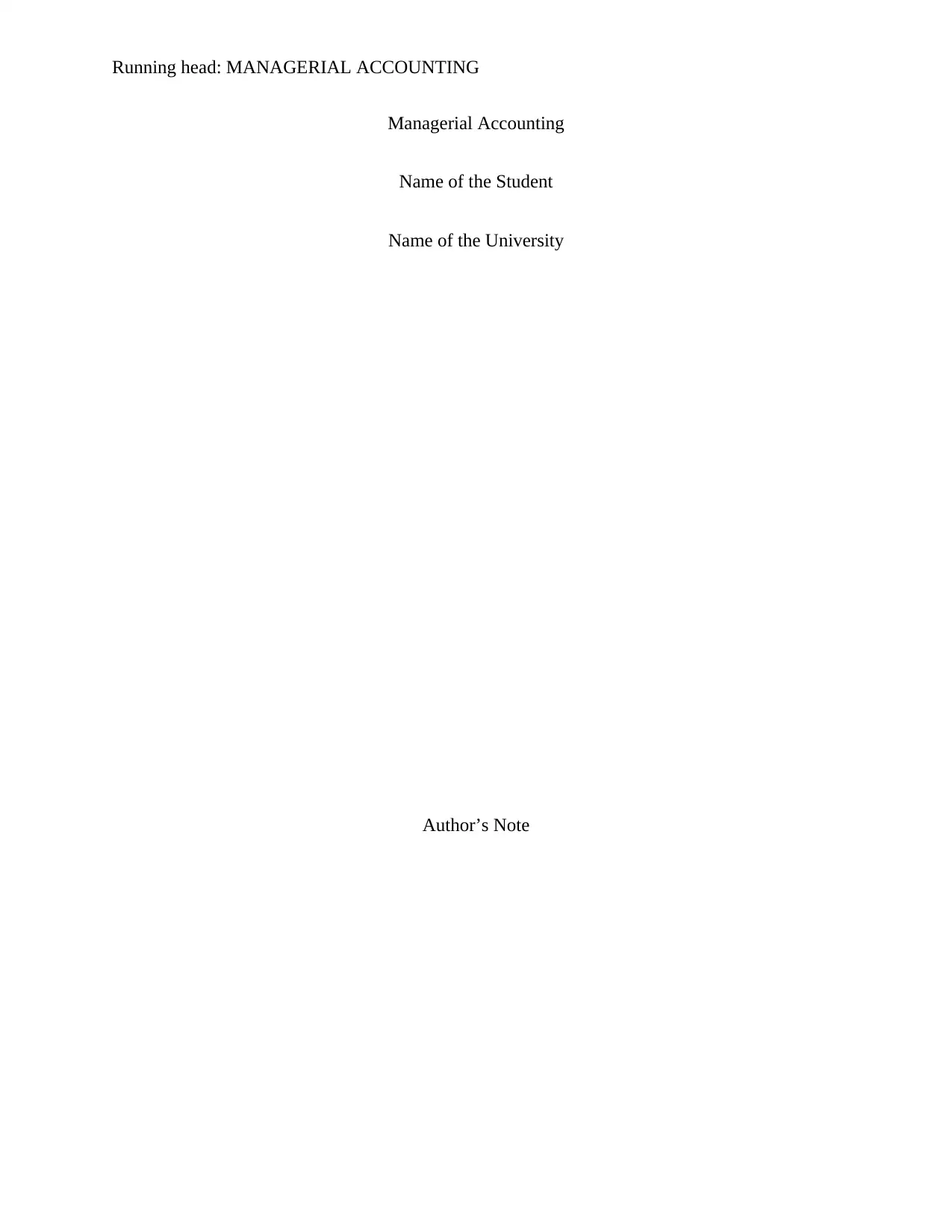
Running head: MANAGERIAL ACCOUNTING
Managerial Accounting
Name of the Student
Name of the University
Author’s Note
Managerial Accounting
Name of the Student
Name of the University
Author’s Note
Paraphrase This Document
Need a fresh take? Get an instant paraphrase of this document with our AI Paraphraser
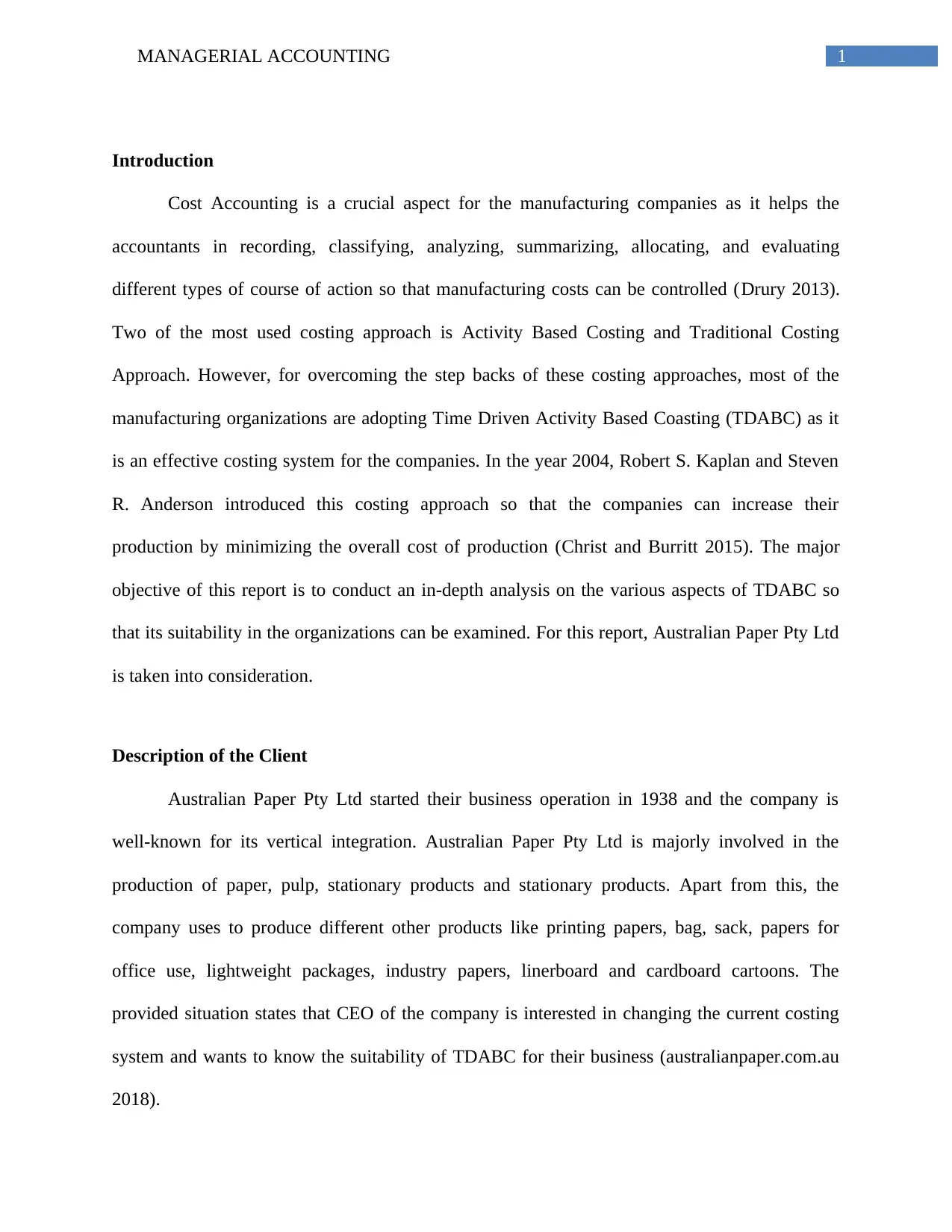
1MANAGERIAL ACCOUNTING
Introduction
Cost Accounting is a crucial aspect for the manufacturing companies as it helps the
accountants in recording, classifying, analyzing, summarizing, allocating, and evaluating
different types of course of action so that manufacturing costs can be controlled (Drury 2013).
Two of the most used costing approach is Activity Based Costing and Traditional Costing
Approach. However, for overcoming the step backs of these costing approaches, most of the
manufacturing organizations are adopting Time Driven Activity Based Coasting (TDABC) as it
is an effective costing system for the companies. In the year 2004, Robert S. Kaplan and Steven
R. Anderson introduced this costing approach so that the companies can increase their
production by minimizing the overall cost of production (Christ and Burritt 2015). The major
objective of this report is to conduct an in-depth analysis on the various aspects of TDABC so
that its suitability in the organizations can be examined. For this report, Australian Paper Pty Ltd
is taken into consideration.
Description of the Client
Australian Paper Pty Ltd started their business operation in 1938 and the company is
well-known for its vertical integration. Australian Paper Pty Ltd is majorly involved in the
production of paper, pulp, stationary products and stationary products. Apart from this, the
company uses to produce different other products like printing papers, bag, sack, papers for
office use, lightweight packages, industry papers, linerboard and cardboard cartoons. The
provided situation states that CEO of the company is interested in changing the current costing
system and wants to know the suitability of TDABC for their business (australianpaper.com.au
2018).
Introduction
Cost Accounting is a crucial aspect for the manufacturing companies as it helps the
accountants in recording, classifying, analyzing, summarizing, allocating, and evaluating
different types of course of action so that manufacturing costs can be controlled (Drury 2013).
Two of the most used costing approach is Activity Based Costing and Traditional Costing
Approach. However, for overcoming the step backs of these costing approaches, most of the
manufacturing organizations are adopting Time Driven Activity Based Coasting (TDABC) as it
is an effective costing system for the companies. In the year 2004, Robert S. Kaplan and Steven
R. Anderson introduced this costing approach so that the companies can increase their
production by minimizing the overall cost of production (Christ and Burritt 2015). The major
objective of this report is to conduct an in-depth analysis on the various aspects of TDABC so
that its suitability in the organizations can be examined. For this report, Australian Paper Pty Ltd
is taken into consideration.
Description of the Client
Australian Paper Pty Ltd started their business operation in 1938 and the company is
well-known for its vertical integration. Australian Paper Pty Ltd is majorly involved in the
production of paper, pulp, stationary products and stationary products. Apart from this, the
company uses to produce different other products like printing papers, bag, sack, papers for
office use, lightweight packages, industry papers, linerboard and cardboard cartoons. The
provided situation states that CEO of the company is interested in changing the current costing
system and wants to know the suitability of TDABC for their business (australianpaper.com.au
2018).
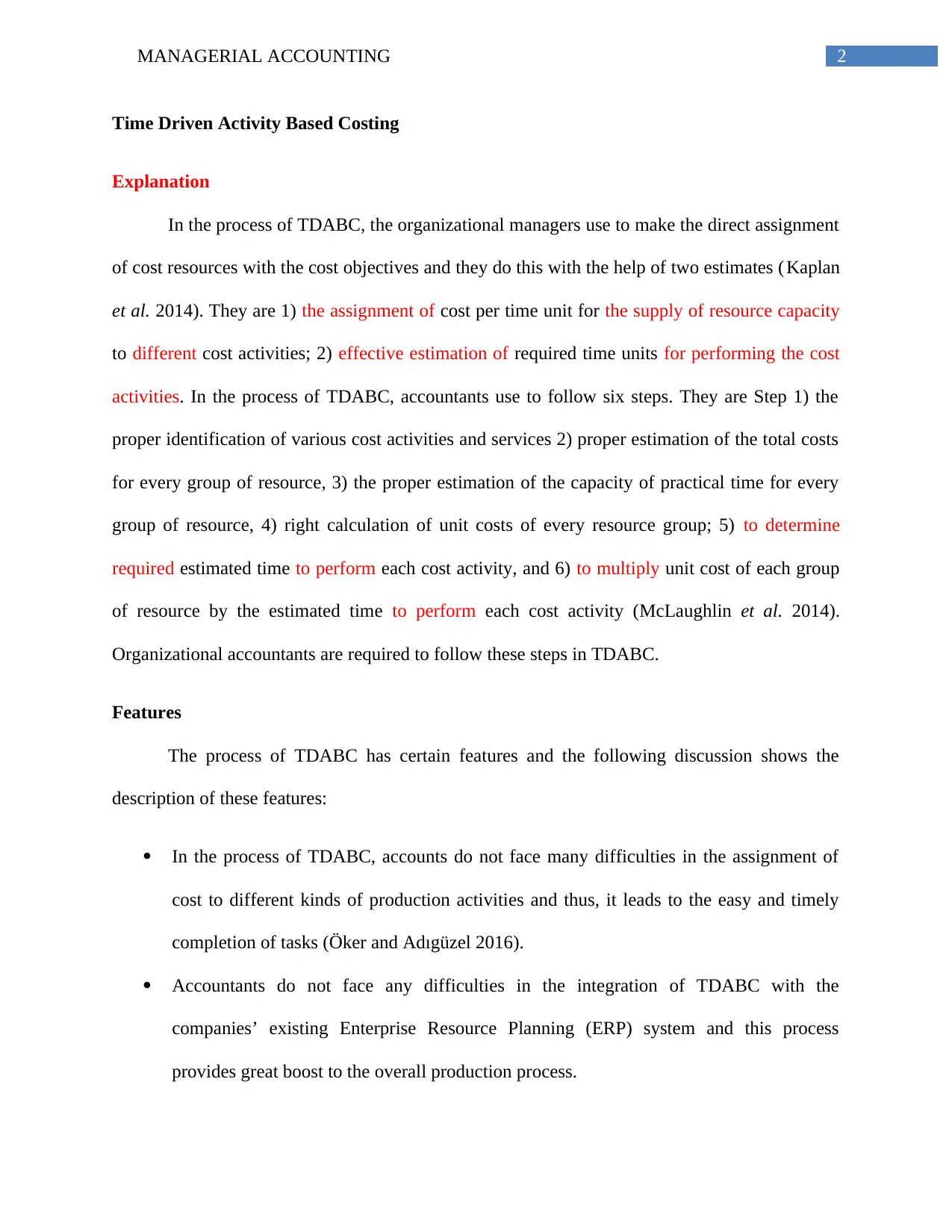
2MANAGERIAL ACCOUNTING
Time Driven Activity Based Costing
Explanation
In the process of TDABC, the organizational managers use to make the direct assignment
of cost resources with the cost objectives and they do this with the help of two estimates ( Kaplan
et al. 2014). They are 1) the assignment of cost per time unit for the supply of resource capacity
to different cost activities; 2) effective estimation of required time units for performing the cost
activities. In the process of TDABC, accountants use to follow six steps. They are Step 1) the
proper identification of various cost activities and services 2) proper estimation of the total costs
for every group of resource, 3) the proper estimation of the capacity of practical time for every
group of resource, 4) right calculation of unit costs of every resource group; 5) to determine
required estimated time to perform each cost activity, and 6) to multiply unit cost of each group
of resource by the estimated time to perform each cost activity (McLaughlin et al. 2014).
Organizational accountants are required to follow these steps in TDABC.
Features
The process of TDABC has certain features and the following discussion shows the
description of these features:
In the process of TDABC, accounts do not face many difficulties in the assignment of
cost to different kinds of production activities and thus, it leads to the easy and timely
completion of tasks (Öker and Adıgüzel 2016).
Accountants do not face any difficulties in the integration of TDABC with the
companies’ existing Enterprise Resource Planning (ERP) system and this process
provides great boost to the overall production process.
Time Driven Activity Based Costing
Explanation
In the process of TDABC, the organizational managers use to make the direct assignment
of cost resources with the cost objectives and they do this with the help of two estimates ( Kaplan
et al. 2014). They are 1) the assignment of cost per time unit for the supply of resource capacity
to different cost activities; 2) effective estimation of required time units for performing the cost
activities. In the process of TDABC, accountants use to follow six steps. They are Step 1) the
proper identification of various cost activities and services 2) proper estimation of the total costs
for every group of resource, 3) the proper estimation of the capacity of practical time for every
group of resource, 4) right calculation of unit costs of every resource group; 5) to determine
required estimated time to perform each cost activity, and 6) to multiply unit cost of each group
of resource by the estimated time to perform each cost activity (McLaughlin et al. 2014).
Organizational accountants are required to follow these steps in TDABC.
Features
The process of TDABC has certain features and the following discussion shows the
description of these features:
In the process of TDABC, accounts do not face many difficulties in the assignment of
cost to different kinds of production activities and thus, it leads to the easy and timely
completion of tasks (Öker and Adıgüzel 2016).
Accountants do not face any difficulties in the integration of TDABC with the
companies’ existing Enterprise Resource Planning (ERP) system and this process
provides great boost to the overall production process.
⊘ This is a preview!⊘
Do you want full access?
Subscribe today to unlock all pages.

Trusted by 1+ million students worldwide
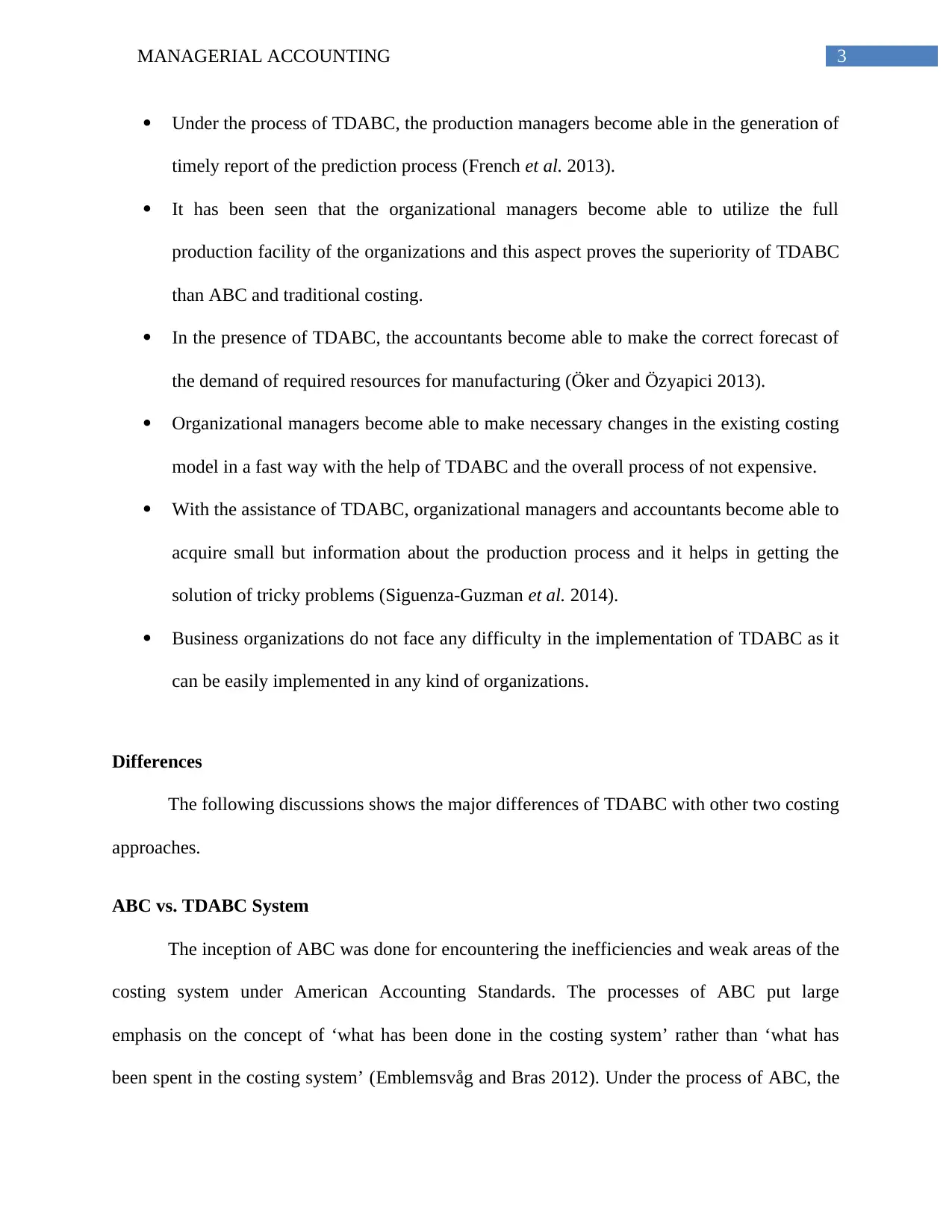
3MANAGERIAL ACCOUNTING
Under the process of TDABC, the production managers become able in the generation of
timely report of the prediction process (French et al. 2013).
It has been seen that the organizational managers become able to utilize the full
production facility of the organizations and this aspect proves the superiority of TDABC
than ABC and traditional costing.
In the presence of TDABC, the accountants become able to make the correct forecast of
the demand of required resources for manufacturing (Öker and Özyapici 2013).
Organizational managers become able to make necessary changes in the existing costing
model in a fast way with the help of TDABC and the overall process of not expensive.
With the assistance of TDABC, organizational managers and accountants become able to
acquire small but information about the production process and it helps in getting the
solution of tricky problems (Siguenza-Guzman et al. 2014).
Business organizations do not face any difficulty in the implementation of TDABC as it
can be easily implemented in any kind of organizations.
Differences
The following discussions shows the major differences of TDABC with other two costing
approaches.
ABC vs. TDABC System
The inception of ABC was done for encountering the inefficiencies and weak areas of the
costing system under American Accounting Standards. The processes of ABC put large
emphasis on the concept of ‘what has been done in the costing system’ rather than ‘what has
been spent in the costing system’ (Emblemsvåg and Bras 2012). Under the process of ABC, the
Under the process of TDABC, the production managers become able in the generation of
timely report of the prediction process (French et al. 2013).
It has been seen that the organizational managers become able to utilize the full
production facility of the organizations and this aspect proves the superiority of TDABC
than ABC and traditional costing.
In the presence of TDABC, the accountants become able to make the correct forecast of
the demand of required resources for manufacturing (Öker and Özyapici 2013).
Organizational managers become able to make necessary changes in the existing costing
model in a fast way with the help of TDABC and the overall process of not expensive.
With the assistance of TDABC, organizational managers and accountants become able to
acquire small but information about the production process and it helps in getting the
solution of tricky problems (Siguenza-Guzman et al. 2014).
Business organizations do not face any difficulty in the implementation of TDABC as it
can be easily implemented in any kind of organizations.
Differences
The following discussions shows the major differences of TDABC with other two costing
approaches.
ABC vs. TDABC System
The inception of ABC was done for encountering the inefficiencies and weak areas of the
costing system under American Accounting Standards. The processes of ABC put large
emphasis on the concept of ‘what has been done in the costing system’ rather than ‘what has
been spent in the costing system’ (Emblemsvåg and Bras 2012). Under the process of ABC, the
Paraphrase This Document
Need a fresh take? Get an instant paraphrase of this document with our AI Paraphraser
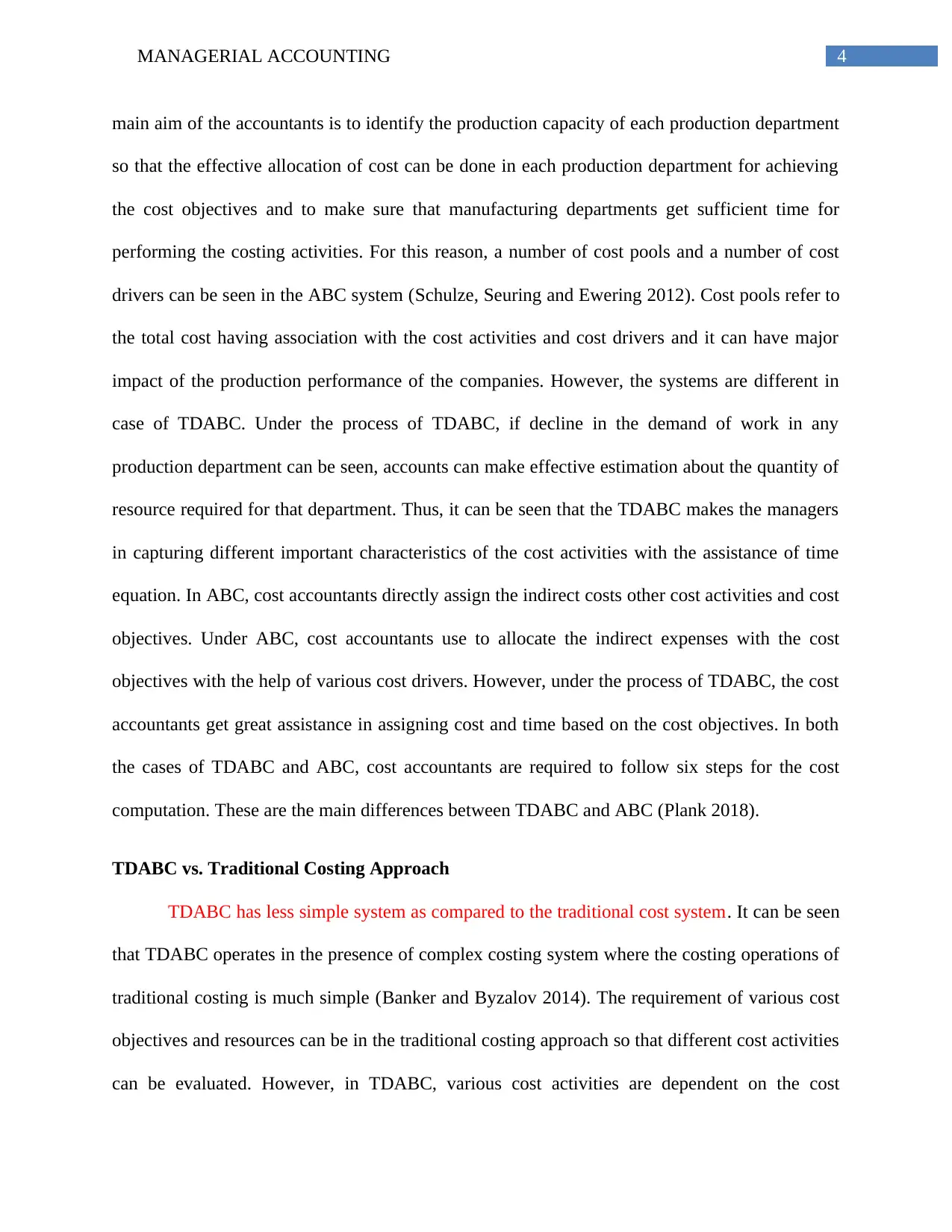
4MANAGERIAL ACCOUNTING
main aim of the accountants is to identify the production capacity of each production department
so that the effective allocation of cost can be done in each production department for achieving
the cost objectives and to make sure that manufacturing departments get sufficient time for
performing the costing activities. For this reason, a number of cost pools and a number of cost
drivers can be seen in the ABC system (Schulze, Seuring and Ewering 2012). Cost pools refer to
the total cost having association with the cost activities and cost drivers and it can have major
impact of the production performance of the companies. However, the systems are different in
case of TDABC. Under the process of TDABC, if decline in the demand of work in any
production department can be seen, accounts can make effective estimation about the quantity of
resource required for that department. Thus, it can be seen that the TDABC makes the managers
in capturing different important characteristics of the cost activities with the assistance of time
equation. In ABC, cost accountants directly assign the indirect costs other cost activities and cost
objectives. Under ABC, cost accountants use to allocate the indirect expenses with the cost
objectives with the help of various cost drivers. However, under the process of TDABC, the cost
accountants get great assistance in assigning cost and time based on the cost objectives. In both
the cases of TDABC and ABC, cost accountants are required to follow six steps for the cost
computation. These are the main differences between TDABC and ABC (Plank 2018).
TDABC vs. Traditional Costing Approach
TDABC has less simple system as compared to the traditional cost system. It can be seen
that TDABC operates in the presence of complex costing system where the costing operations of
traditional costing is much simple (Banker and Byzalov 2014). The requirement of various cost
objectives and resources can be in the traditional costing approach so that different cost activities
can be evaluated. However, in TDABC, various cost activities are dependent on the cost
main aim of the accountants is to identify the production capacity of each production department
so that the effective allocation of cost can be done in each production department for achieving
the cost objectives and to make sure that manufacturing departments get sufficient time for
performing the costing activities. For this reason, a number of cost pools and a number of cost
drivers can be seen in the ABC system (Schulze, Seuring and Ewering 2012). Cost pools refer to
the total cost having association with the cost activities and cost drivers and it can have major
impact of the production performance of the companies. However, the systems are different in
case of TDABC. Under the process of TDABC, if decline in the demand of work in any
production department can be seen, accounts can make effective estimation about the quantity of
resource required for that department. Thus, it can be seen that the TDABC makes the managers
in capturing different important characteristics of the cost activities with the assistance of time
equation. In ABC, cost accountants directly assign the indirect costs other cost activities and cost
objectives. Under ABC, cost accountants use to allocate the indirect expenses with the cost
objectives with the help of various cost drivers. However, under the process of TDABC, the cost
accountants get great assistance in assigning cost and time based on the cost objectives. In both
the cases of TDABC and ABC, cost accountants are required to follow six steps for the cost
computation. These are the main differences between TDABC and ABC (Plank 2018).
TDABC vs. Traditional Costing Approach
TDABC has less simple system as compared to the traditional cost system. It can be seen
that TDABC operates in the presence of complex costing system where the costing operations of
traditional costing is much simple (Banker and Byzalov 2014). The requirement of various cost
objectives and resources can be in the traditional costing approach so that different cost activities
can be evaluated. However, in TDABC, various cost activities are dependent on the cost
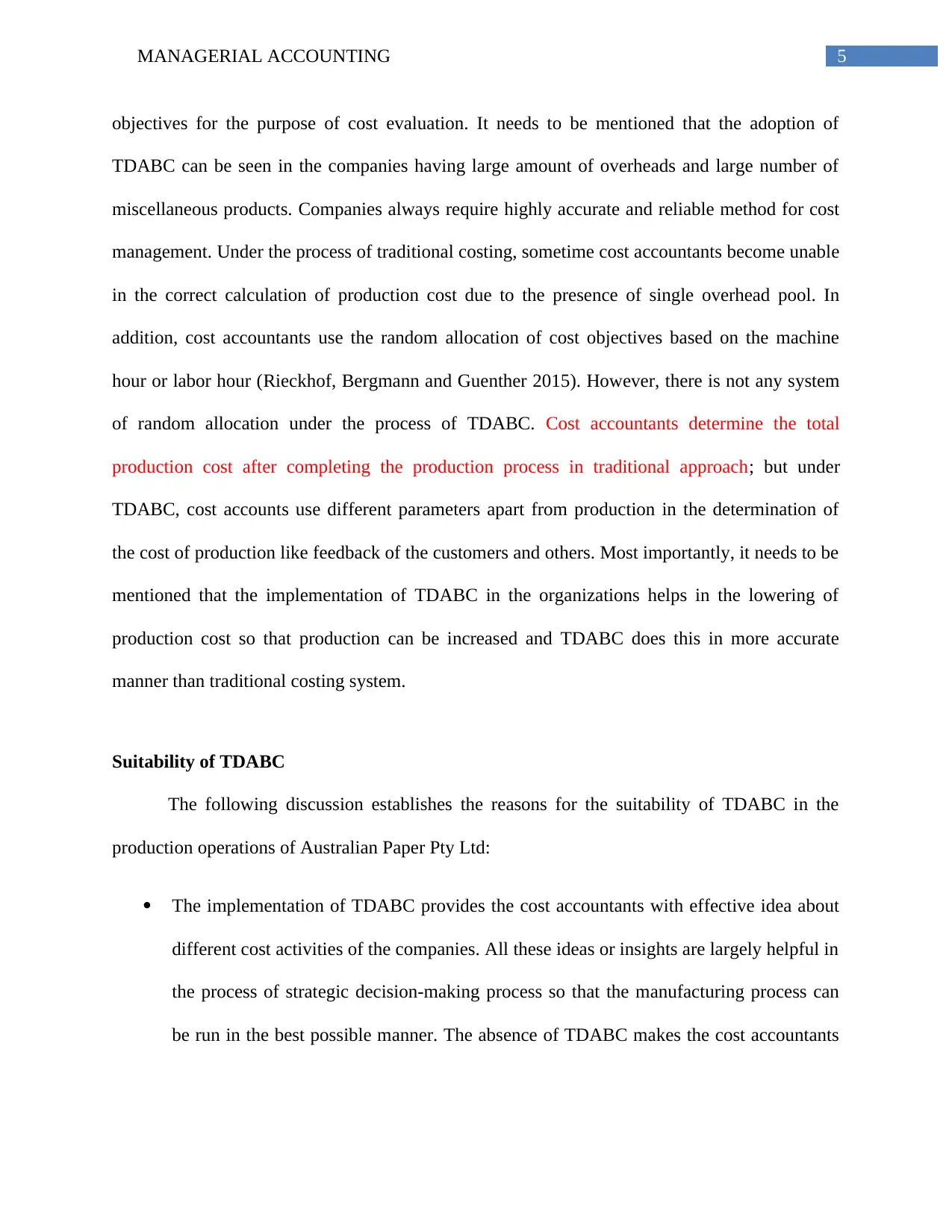
5MANAGERIAL ACCOUNTING
objectives for the purpose of cost evaluation. It needs to be mentioned that the adoption of
TDABC can be seen in the companies having large amount of overheads and large number of
miscellaneous products. Companies always require highly accurate and reliable method for cost
management. Under the process of traditional costing, sometime cost accountants become unable
in the correct calculation of production cost due to the presence of single overhead pool. In
addition, cost accountants use the random allocation of cost objectives based on the machine
hour or labor hour (Rieckhof, Bergmann and Guenther 2015). However, there is not any system
of random allocation under the process of TDABC. Cost accountants determine the total
production cost after completing the production process in traditional approach; but under
TDABC, cost accounts use different parameters apart from production in the determination of
the cost of production like feedback of the customers and others. Most importantly, it needs to be
mentioned that the implementation of TDABC in the organizations helps in the lowering of
production cost so that production can be increased and TDABC does this in more accurate
manner than traditional costing system.
Suitability of TDABC
The following discussion establishes the reasons for the suitability of TDABC in the
production operations of Australian Paper Pty Ltd:
The implementation of TDABC provides the cost accountants with effective idea about
different cost activities of the companies. All these ideas or insights are largely helpful in
the process of strategic decision-making process so that the manufacturing process can
be run in the best possible manner. The absence of TDABC makes the cost accountants
objectives for the purpose of cost evaluation. It needs to be mentioned that the adoption of
TDABC can be seen in the companies having large amount of overheads and large number of
miscellaneous products. Companies always require highly accurate and reliable method for cost
management. Under the process of traditional costing, sometime cost accountants become unable
in the correct calculation of production cost due to the presence of single overhead pool. In
addition, cost accountants use the random allocation of cost objectives based on the machine
hour or labor hour (Rieckhof, Bergmann and Guenther 2015). However, there is not any system
of random allocation under the process of TDABC. Cost accountants determine the total
production cost after completing the production process in traditional approach; but under
TDABC, cost accounts use different parameters apart from production in the determination of
the cost of production like feedback of the customers and others. Most importantly, it needs to be
mentioned that the implementation of TDABC in the organizations helps in the lowering of
production cost so that production can be increased and TDABC does this in more accurate
manner than traditional costing system.
Suitability of TDABC
The following discussion establishes the reasons for the suitability of TDABC in the
production operations of Australian Paper Pty Ltd:
The implementation of TDABC provides the cost accountants with effective idea about
different cost activities of the companies. All these ideas or insights are largely helpful in
the process of strategic decision-making process so that the manufacturing process can
be run in the best possible manner. The absence of TDABC makes the cost accountants
⊘ This is a preview!⊘
Do you want full access?
Subscribe today to unlock all pages.

Trusted by 1+ million students worldwide
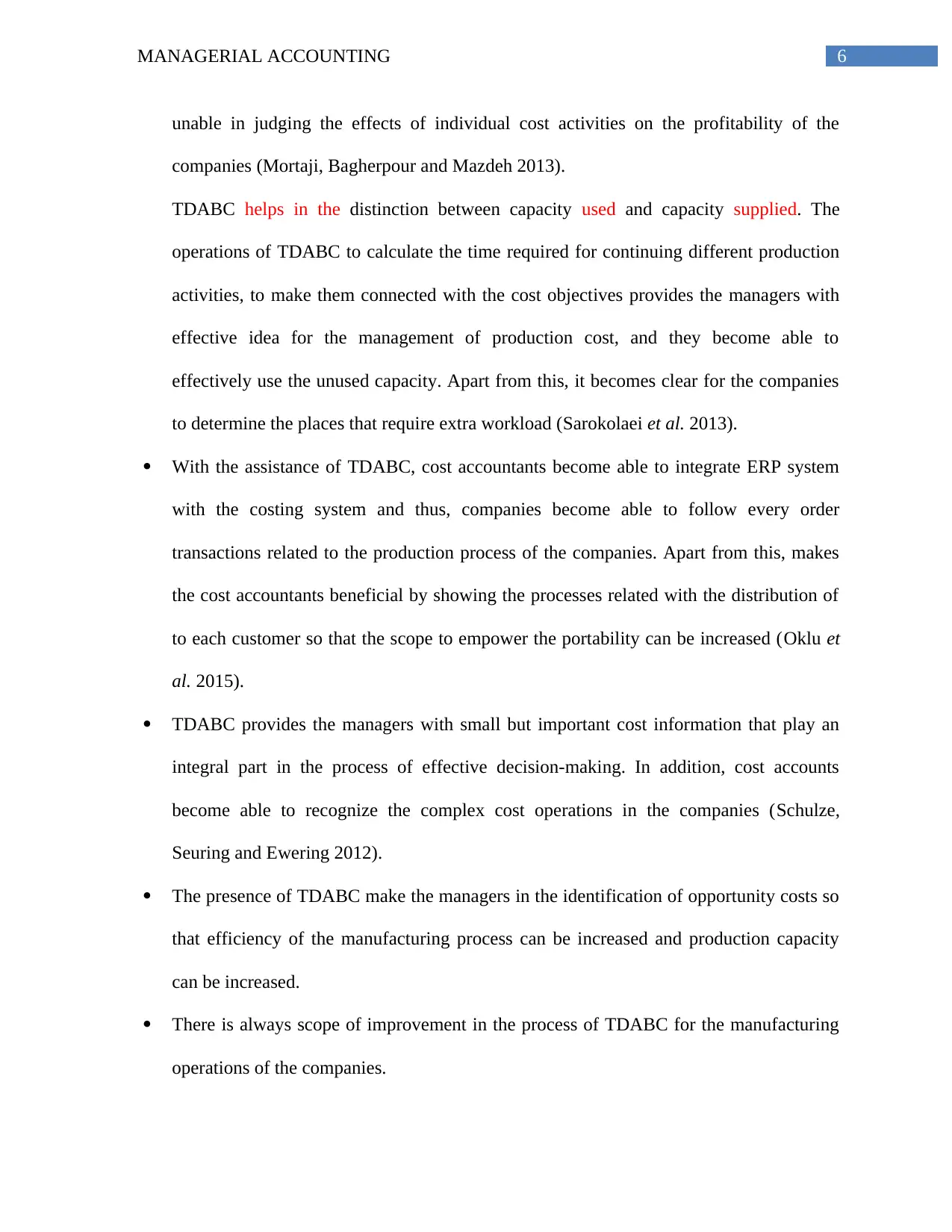
6MANAGERIAL ACCOUNTING
unable in judging the effects of individual cost activities on the profitability of the
companies (Mortaji, Bagherpour and Mazdeh 2013).
TDABC helps in the distinction between capacity used and capacity supplied. The
operations of TDABC to calculate the time required for continuing different production
activities, to make them connected with the cost objectives provides the managers with
effective idea for the management of production cost, and they become able to
effectively use the unused capacity. Apart from this, it becomes clear for the companies
to determine the places that require extra workload (Sarokolaei et al. 2013).
With the assistance of TDABC, cost accountants become able to integrate ERP system
with the costing system and thus, companies become able to follow every order
transactions related to the production process of the companies. Apart from this, makes
the cost accountants beneficial by showing the processes related with the distribution of
to each customer so that the scope to empower the portability can be increased (Oklu et
al. 2015).
TDABC provides the managers with small but important cost information that play an
integral part in the process of effective decision-making. In addition, cost accounts
become able to recognize the complex cost operations in the companies (Schulze,
Seuring and Ewering 2012).
The presence of TDABC make the managers in the identification of opportunity costs so
that efficiency of the manufacturing process can be increased and production capacity
can be increased.
There is always scope of improvement in the process of TDABC for the manufacturing
operations of the companies.
unable in judging the effects of individual cost activities on the profitability of the
companies (Mortaji, Bagherpour and Mazdeh 2013).
TDABC helps in the distinction between capacity used and capacity supplied. The
operations of TDABC to calculate the time required for continuing different production
activities, to make them connected with the cost objectives provides the managers with
effective idea for the management of production cost, and they become able to
effectively use the unused capacity. Apart from this, it becomes clear for the companies
to determine the places that require extra workload (Sarokolaei et al. 2013).
With the assistance of TDABC, cost accountants become able to integrate ERP system
with the costing system and thus, companies become able to follow every order
transactions related to the production process of the companies. Apart from this, makes
the cost accountants beneficial by showing the processes related with the distribution of
to each customer so that the scope to empower the portability can be increased (Oklu et
al. 2015).
TDABC provides the managers with small but important cost information that play an
integral part in the process of effective decision-making. In addition, cost accounts
become able to recognize the complex cost operations in the companies (Schulze,
Seuring and Ewering 2012).
The presence of TDABC make the managers in the identification of opportunity costs so
that efficiency of the manufacturing process can be increased and production capacity
can be increased.
There is always scope of improvement in the process of TDABC for the manufacturing
operations of the companies.
Paraphrase This Document
Need a fresh take? Get an instant paraphrase of this document with our AI Paraphraser
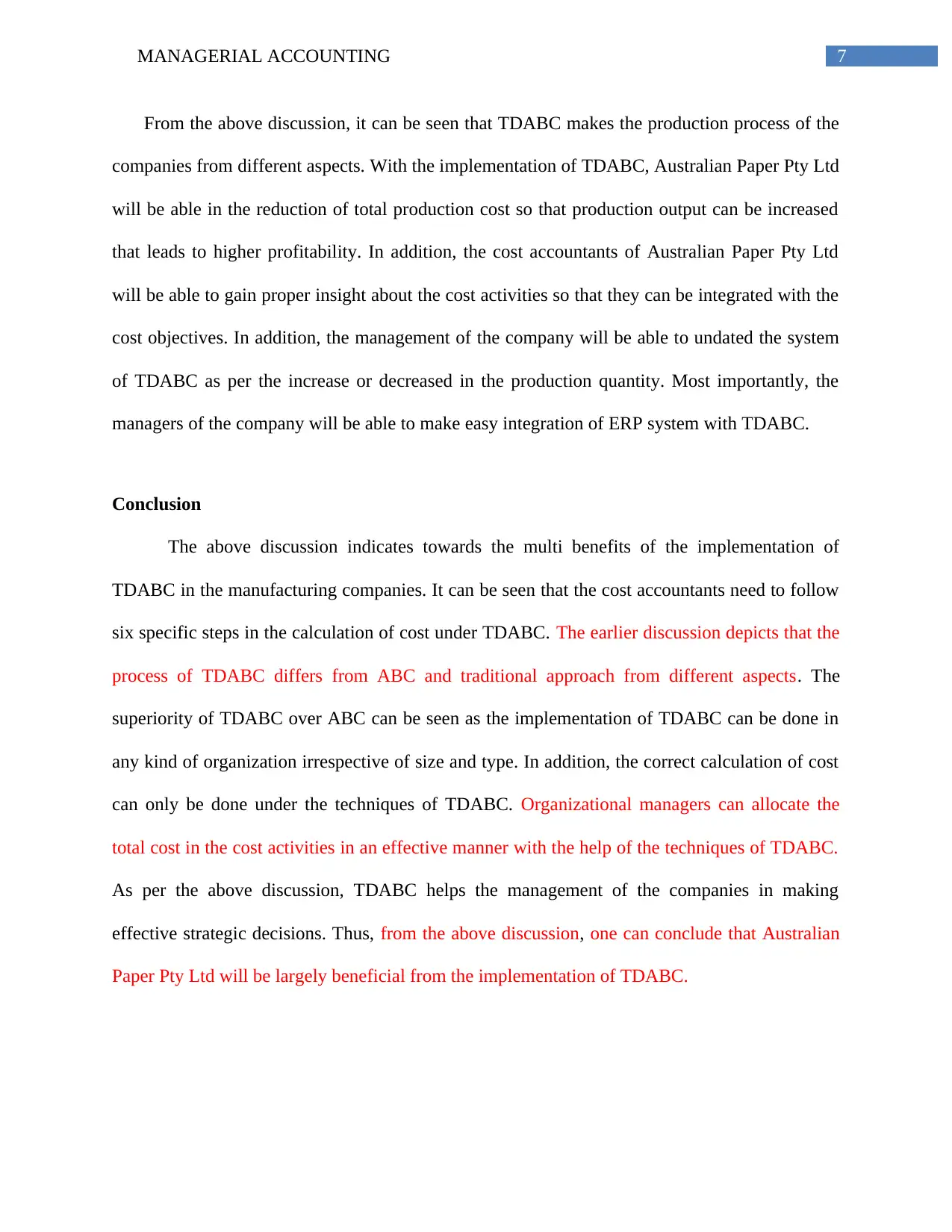
7MANAGERIAL ACCOUNTING
From the above discussion, it can be seen that TDABC makes the production process of the
companies from different aspects. With the implementation of TDABC, Australian Paper Pty Ltd
will be able in the reduction of total production cost so that production output can be increased
that leads to higher profitability. In addition, the cost accountants of Australian Paper Pty Ltd
will be able to gain proper insight about the cost activities so that they can be integrated with the
cost objectives. In addition, the management of the company will be able to undated the system
of TDABC as per the increase or decreased in the production quantity. Most importantly, the
managers of the company will be able to make easy integration of ERP system with TDABC.
Conclusion
The above discussion indicates towards the multi benefits of the implementation of
TDABC in the manufacturing companies. It can be seen that the cost accountants need to follow
six specific steps in the calculation of cost under TDABC. The earlier discussion depicts that the
process of TDABC differs from ABC and traditional approach from different aspects. The
superiority of TDABC over ABC can be seen as the implementation of TDABC can be done in
any kind of organization irrespective of size and type. In addition, the correct calculation of cost
can only be done under the techniques of TDABC. Organizational managers can allocate the
total cost in the cost activities in an effective manner with the help of the techniques of TDABC.
As per the above discussion, TDABC helps the management of the companies in making
effective strategic decisions. Thus, from the above discussion, one can conclude that Australian
Paper Pty Ltd will be largely beneficial from the implementation of TDABC.
From the above discussion, it can be seen that TDABC makes the production process of the
companies from different aspects. With the implementation of TDABC, Australian Paper Pty Ltd
will be able in the reduction of total production cost so that production output can be increased
that leads to higher profitability. In addition, the cost accountants of Australian Paper Pty Ltd
will be able to gain proper insight about the cost activities so that they can be integrated with the
cost objectives. In addition, the management of the company will be able to undated the system
of TDABC as per the increase or decreased in the production quantity. Most importantly, the
managers of the company will be able to make easy integration of ERP system with TDABC.
Conclusion
The above discussion indicates towards the multi benefits of the implementation of
TDABC in the manufacturing companies. It can be seen that the cost accountants need to follow
six specific steps in the calculation of cost under TDABC. The earlier discussion depicts that the
process of TDABC differs from ABC and traditional approach from different aspects. The
superiority of TDABC over ABC can be seen as the implementation of TDABC can be done in
any kind of organization irrespective of size and type. In addition, the correct calculation of cost
can only be done under the techniques of TDABC. Organizational managers can allocate the
total cost in the cost activities in an effective manner with the help of the techniques of TDABC.
As per the above discussion, TDABC helps the management of the companies in making
effective strategic decisions. Thus, from the above discussion, one can conclude that Australian
Paper Pty Ltd will be largely beneficial from the implementation of TDABC.
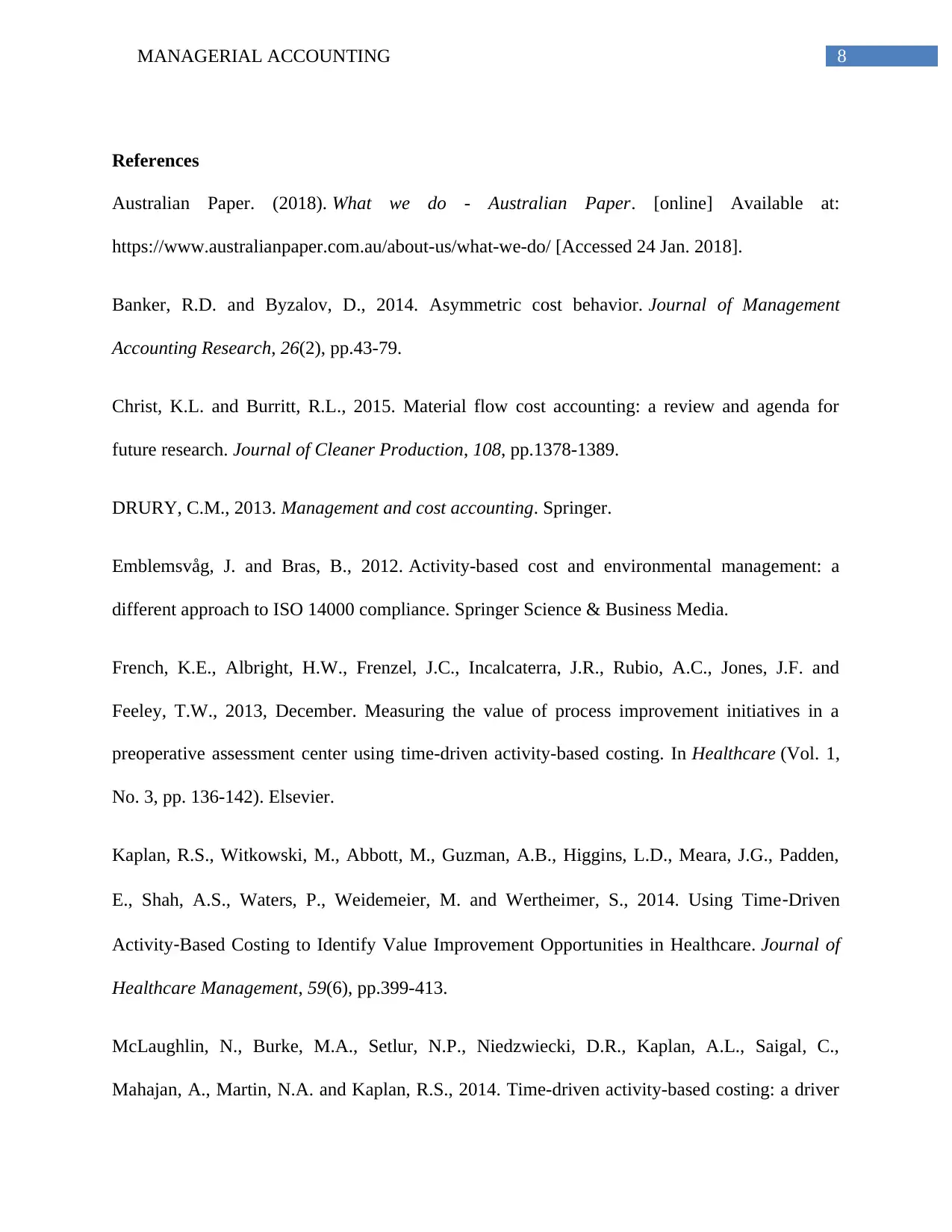
8MANAGERIAL ACCOUNTING
References
Australian Paper. (2018). What we do - Australian Paper. [online] Available at:
https://www.australianpaper.com.au/about-us/what-we-do/ [Accessed 24 Jan. 2018].
Banker, R.D. and Byzalov, D., 2014. Asymmetric cost behavior. Journal of Management
Accounting Research, 26(2), pp.43-79.
Christ, K.L. and Burritt, R.L., 2015. Material flow cost accounting: a review and agenda for
future research. Journal of Cleaner Production, 108, pp.1378-1389.
DRURY, C.M., 2013. Management and cost accounting. Springer.
Emblemsvåg, J. and Bras, B., 2012. Activity-based cost and environmental management: a
different approach to ISO 14000 compliance. Springer Science & Business Media.
French, K.E., Albright, H.W., Frenzel, J.C., Incalcaterra, J.R., Rubio, A.C., Jones, J.F. and
Feeley, T.W., 2013, December. Measuring the value of process improvement initiatives in a
preoperative assessment center using time-driven activity-based costing. In Healthcare (Vol. 1,
No. 3, pp. 136-142). Elsevier.
Kaplan, R.S., Witkowski, M., Abbott, M., Guzman, A.B., Higgins, L.D., Meara, J.G., Padden,
E., Shah, A.S., Waters, P., Weidemeier, M. and Wertheimer, S., 2014. Using Time‐Driven
Activity‐Based Costing to Identify Value Improvement Opportunities in Healthcare. Journal of
Healthcare Management, 59(6), pp.399-413.
McLaughlin, N., Burke, M.A., Setlur, N.P., Niedzwiecki, D.R., Kaplan, A.L., Saigal, C.,
Mahajan, A., Martin, N.A. and Kaplan, R.S., 2014. Time-driven activity-based costing: a driver
References
Australian Paper. (2018). What we do - Australian Paper. [online] Available at:
https://www.australianpaper.com.au/about-us/what-we-do/ [Accessed 24 Jan. 2018].
Banker, R.D. and Byzalov, D., 2014. Asymmetric cost behavior. Journal of Management
Accounting Research, 26(2), pp.43-79.
Christ, K.L. and Burritt, R.L., 2015. Material flow cost accounting: a review and agenda for
future research. Journal of Cleaner Production, 108, pp.1378-1389.
DRURY, C.M., 2013. Management and cost accounting. Springer.
Emblemsvåg, J. and Bras, B., 2012. Activity-based cost and environmental management: a
different approach to ISO 14000 compliance. Springer Science & Business Media.
French, K.E., Albright, H.W., Frenzel, J.C., Incalcaterra, J.R., Rubio, A.C., Jones, J.F. and
Feeley, T.W., 2013, December. Measuring the value of process improvement initiatives in a
preoperative assessment center using time-driven activity-based costing. In Healthcare (Vol. 1,
No. 3, pp. 136-142). Elsevier.
Kaplan, R.S., Witkowski, M., Abbott, M., Guzman, A.B., Higgins, L.D., Meara, J.G., Padden,
E., Shah, A.S., Waters, P., Weidemeier, M. and Wertheimer, S., 2014. Using Time‐Driven
Activity‐Based Costing to Identify Value Improvement Opportunities in Healthcare. Journal of
Healthcare Management, 59(6), pp.399-413.
McLaughlin, N., Burke, M.A., Setlur, N.P., Niedzwiecki, D.R., Kaplan, A.L., Saigal, C.,
Mahajan, A., Martin, N.A. and Kaplan, R.S., 2014. Time-driven activity-based costing: a driver
⊘ This is a preview!⊘
Do you want full access?
Subscribe today to unlock all pages.

Trusted by 1+ million students worldwide
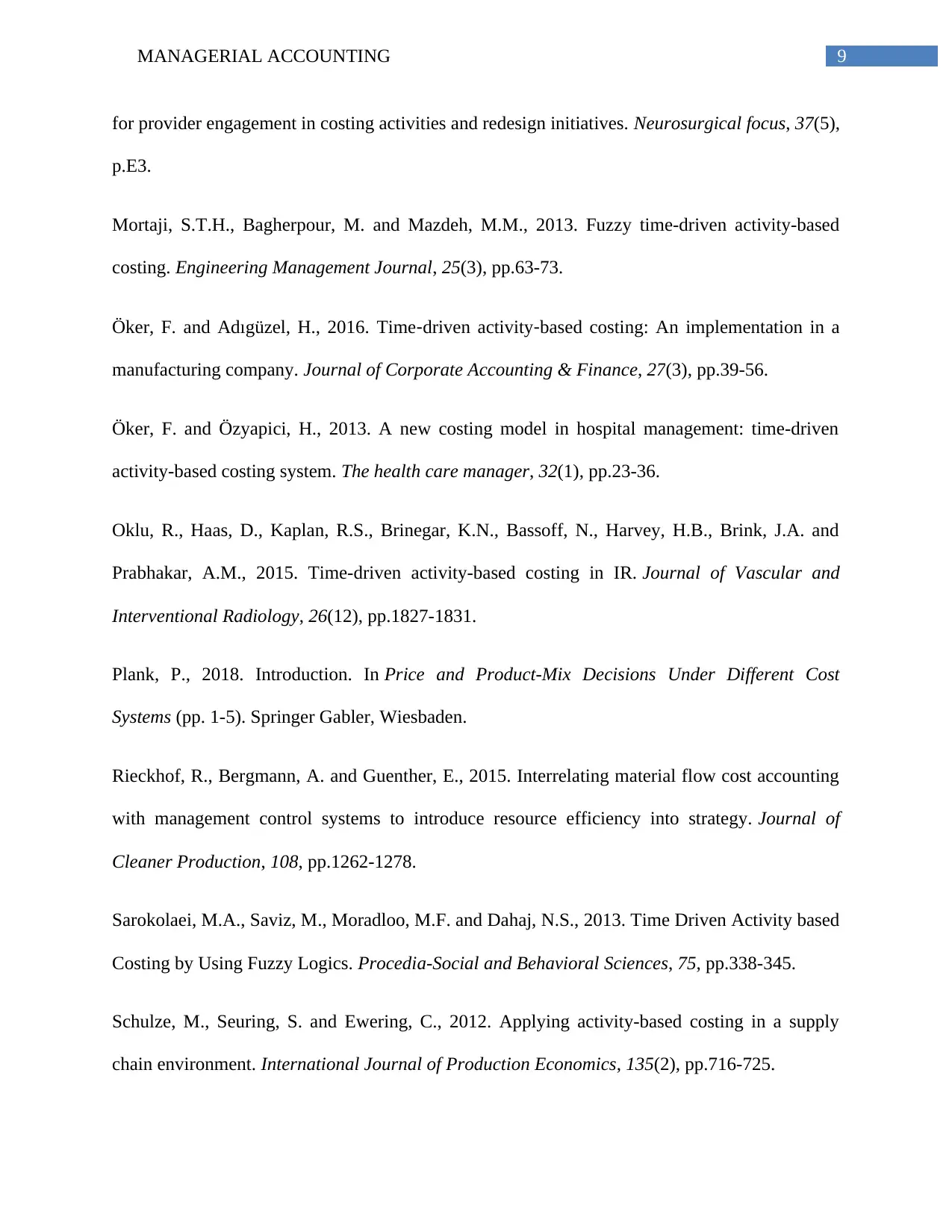
9MANAGERIAL ACCOUNTING
for provider engagement in costing activities and redesign initiatives. Neurosurgical focus, 37(5),
p.E3.
Mortaji, S.T.H., Bagherpour, M. and Mazdeh, M.M., 2013. Fuzzy time-driven activity-based
costing. Engineering Management Journal, 25(3), pp.63-73.
Öker, F. and Adıgüzel, H., 2016. Time‐driven activity‐based costing: An implementation in a
manufacturing company. Journal of Corporate Accounting & Finance, 27(3), pp.39-56.
Öker, F. and Özyapici, H., 2013. A new costing model in hospital management: time-driven
activity-based costing system. The health care manager, 32(1), pp.23-36.
Oklu, R., Haas, D., Kaplan, R.S., Brinegar, K.N., Bassoff, N., Harvey, H.B., Brink, J.A. and
Prabhakar, A.M., 2015. Time-driven activity-based costing in IR. Journal of Vascular and
Interventional Radiology, 26(12), pp.1827-1831.
Plank, P., 2018. Introduction. In Price and Product-Mix Decisions Under Different Cost
Systems (pp. 1-5). Springer Gabler, Wiesbaden.
Rieckhof, R., Bergmann, A. and Guenther, E., 2015. Interrelating material flow cost accounting
with management control systems to introduce resource efficiency into strategy. Journal of
Cleaner Production, 108, pp.1262-1278.
Sarokolaei, M.A., Saviz, M., Moradloo, M.F. and Dahaj, N.S., 2013. Time Driven Activity based
Costing by Using Fuzzy Logics. Procedia-Social and Behavioral Sciences, 75, pp.338-345.
Schulze, M., Seuring, S. and Ewering, C., 2012. Applying activity-based costing in a supply
chain environment. International Journal of Production Economics, 135(2), pp.716-725.
for provider engagement in costing activities and redesign initiatives. Neurosurgical focus, 37(5),
p.E3.
Mortaji, S.T.H., Bagherpour, M. and Mazdeh, M.M., 2013. Fuzzy time-driven activity-based
costing. Engineering Management Journal, 25(3), pp.63-73.
Öker, F. and Adıgüzel, H., 2016. Time‐driven activity‐based costing: An implementation in a
manufacturing company. Journal of Corporate Accounting & Finance, 27(3), pp.39-56.
Öker, F. and Özyapici, H., 2013. A new costing model in hospital management: time-driven
activity-based costing system. The health care manager, 32(1), pp.23-36.
Oklu, R., Haas, D., Kaplan, R.S., Brinegar, K.N., Bassoff, N., Harvey, H.B., Brink, J.A. and
Prabhakar, A.M., 2015. Time-driven activity-based costing in IR. Journal of Vascular and
Interventional Radiology, 26(12), pp.1827-1831.
Plank, P., 2018. Introduction. In Price and Product-Mix Decisions Under Different Cost
Systems (pp. 1-5). Springer Gabler, Wiesbaden.
Rieckhof, R., Bergmann, A. and Guenther, E., 2015. Interrelating material flow cost accounting
with management control systems to introduce resource efficiency into strategy. Journal of
Cleaner Production, 108, pp.1262-1278.
Sarokolaei, M.A., Saviz, M., Moradloo, M.F. and Dahaj, N.S., 2013. Time Driven Activity based
Costing by Using Fuzzy Logics. Procedia-Social and Behavioral Sciences, 75, pp.338-345.
Schulze, M., Seuring, S. and Ewering, C., 2012. Applying activity-based costing in a supply
chain environment. International Journal of Production Economics, 135(2), pp.716-725.
Paraphrase This Document
Need a fresh take? Get an instant paraphrase of this document with our AI Paraphraser
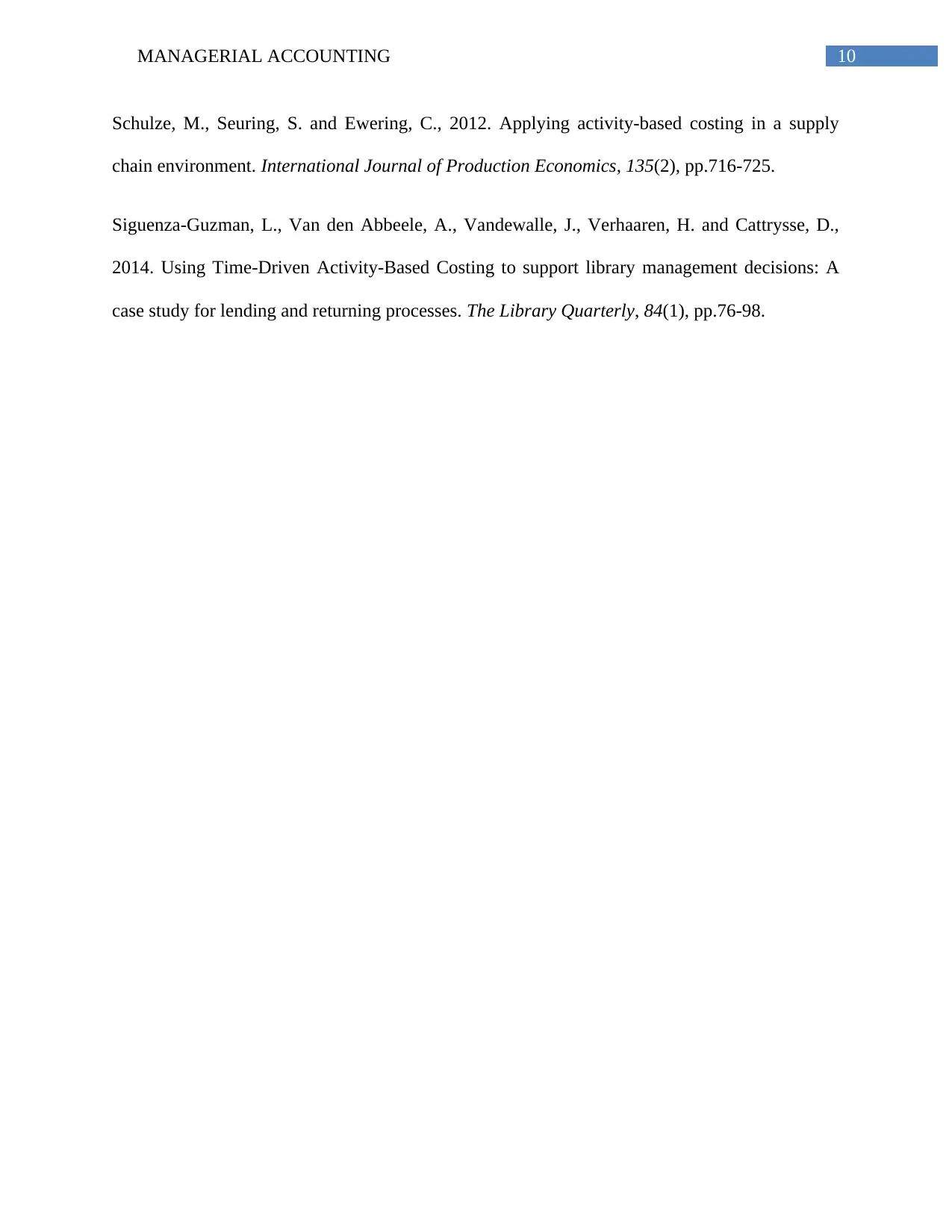
10MANAGERIAL ACCOUNTING
Schulze, M., Seuring, S. and Ewering, C., 2012. Applying activity-based costing in a supply
chain environment. International Journal of Production Economics, 135(2), pp.716-725.
Siguenza-Guzman, L., Van den Abbeele, A., Vandewalle, J., Verhaaren, H. and Cattrysse, D.,
2014. Using Time-Driven Activity-Based Costing to support library management decisions: A
case study for lending and returning processes. The Library Quarterly, 84(1), pp.76-98.
Schulze, M., Seuring, S. and Ewering, C., 2012. Applying activity-based costing in a supply
chain environment. International Journal of Production Economics, 135(2), pp.716-725.
Siguenza-Guzman, L., Van den Abbeele, A., Vandewalle, J., Verhaaren, H. and Cattrysse, D.,
2014. Using Time-Driven Activity-Based Costing to support library management decisions: A
case study for lending and returning processes. The Library Quarterly, 84(1), pp.76-98.
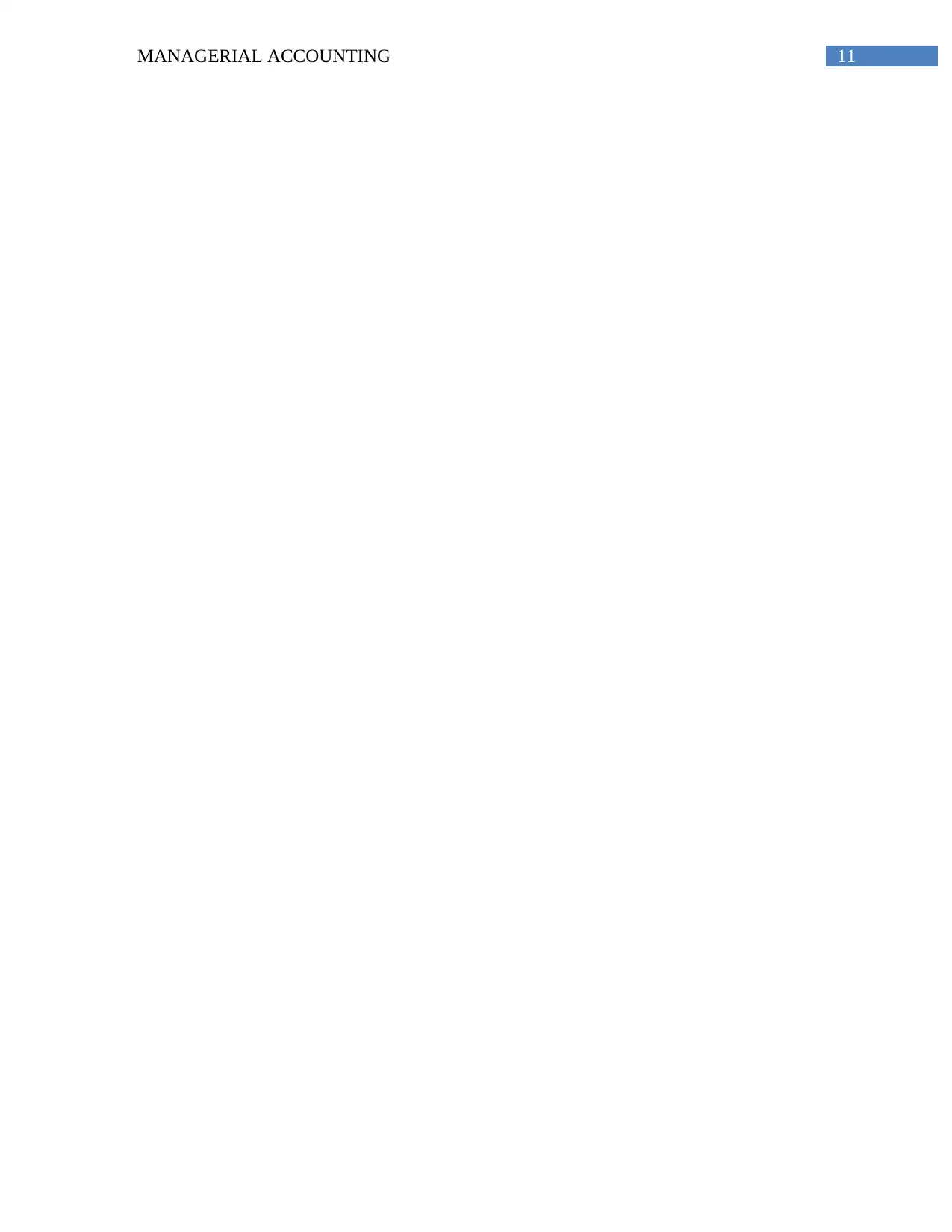
11MANAGERIAL ACCOUNTING
⊘ This is a preview!⊘
Do you want full access?
Subscribe today to unlock all pages.

Trusted by 1+ million students worldwide
1 out of 12
Related Documents
Your All-in-One AI-Powered Toolkit for Academic Success.
+13062052269
info@desklib.com
Available 24*7 on WhatsApp / Email
![[object Object]](/_next/static/media/star-bottom.7253800d.svg)
Unlock your academic potential
Copyright © 2020–2025 A2Z Services. All Rights Reserved. Developed and managed by ZUCOL.





